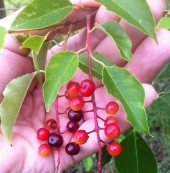




 3
3





"Our ability to change the face of the earth increases at a faster rate than our ability to foresee the consequences of that change"
- L.Charles Birch
My Herbal Tea Store (CA)




Jarret Hynd wrote:I'm thinking no for a chokecherry. Their leaves are bigger and more pointed at the end and less serrated from what I recall. Infact, if you scroll down you will see a related "chokecherry thread " with a thumbnail image

Chokecherries around here grow like a tree would, while your picture is more of a shruby thing. The leaf reminds me of a service berry, but the rest of the pics don't.
If you crack open a chokecherry seed, it gives off a "fruit punch" taste. They are also perfectly round, maybe 1/4 inch in size at most and a kind of dark pale white.
Hopefully someone with more expertise can assist you.
 1
1




I make a Maple Syrup instructional movie! Check it out HERE
SKIP books, get 'em while they're hot!!! Skills to Inherit Property
See me in a movie building a massive wood staircase:Low Tech Lab Movie




Mike Jay wrote:The leaves look a lot like a buckthorn to me.
IF it's a choke cherry, one feature that narrows it down is that the berries are carried on a raceme. That's a long stemlet with the berries hanging off of it on individual stems. So if you pick one raceme, you'd get 10+ berries. Buckthorn hold their berries on individual stems off of the main twig (like a cherry). Most cherries I've seen have longer leaves than that. But the bark does look cherryish to me.
I always recommend getting a couple berry identification books before trying to eat anything. One I particularly like for the upper Midwest is "Wild Berries and Fruits Field Guide" by Teresa Marrone. It fits in your pocket and is easy to take along on walks.
 3
3












I make a Maple Syrup instructional movie! Check it out HERE
SKIP books, get 'em while they're hot!!! Skills to Inherit Property
See me in a movie building a massive wood staircase:Low Tech Lab Movie
 2
2





"Our ability to change the face of the earth increases at a faster rate than our ability to foresee the consequences of that change"
- L.Charles Birch
My Herbal Tea Store (CA)
 3
3








Joylynn Hardesty wrote:Umm. Please don't taste an unknown plant, or fruit, if you have not yet positively identified it. We need all available permies alive and well! This warning is coming from a self taught forager. Beware!
Oh, and I don't know what the tree/shrub is either
 1
1




Mike Jay wrote:Some buckthorns have a "thorn" at the end of the twigs. While the lack of a thorn doesn't mean it isn't buckthorn, the existence of one would be a strong indicator. Where in the world do you live?
 2
2








Jarret Hynd wrote:Do you have Aronia (black chokecherry) where you are? Even though there are some potentially matching characteristics like the Leaves, Seeds and Bark in your pics, I'm doubtful that's it since the one in your pic seems much bigger. But just thought I'd throw my hat in the ring.
They came up a lot in the web results when I was trying to identify the chokecherries in my area awhile ago.
---
I'd honestly taste the berry and see if you can identify it from the dried fruit. It might help
(I picked some dried service berries in late sept and they were crunchy, but still had their distinct taste.)








 1
1








 1
1








“The most important decision we make is whether we believe we live in a friendly or hostile universe.”― Albert Einstein





|
Without subsidies, chem-ag food costs four times more than organic. Or this tiny ad:
Homestead Pigs Course
https://permies.com/wiki/365748/Homestead-Pigs
|








